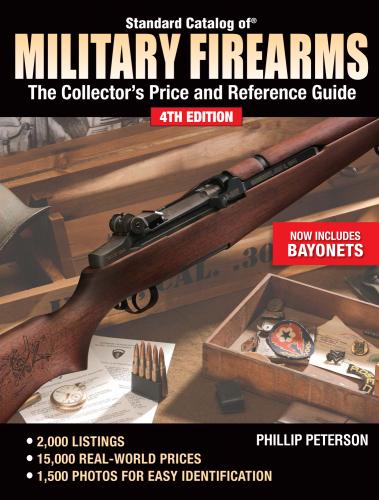Steyr AUG (Armee Universal Gewehr)
Produced by Steyr-Mannlicher beginning in 1978, this rifle is chambered for the 5.56x45mm cartridge. It is a bullpup design with a number of different configurations. Barrel lengths are 13.6" in submachine gun configuration, 16.3" in carbine, 19.8" in rifle, and 24.2" in a heavy barrel sniper configuration. Magazine is 30 or 42 rounds. Carry handle is an optic sight of 1.5 power. Adopted by Austrian army and still in production. Weight is 7.7 lbs. in rifle configuration. Rate of fire is about 650 rounds per minute.
Pre-1986 full-auto conversions of semi-automatic version
| Exc. | V.G. | Good |
| 15000 | 12500 | 10000 |
Steyr AUG (Semi-automatic Version)
As above but in semi-automatic only. Two models, the first with green furniture and fitted with a 20" barrel. The second with black furniture and fitted with a 16" barrel.
MAUSER
M1914 Rifle
This rifle is identical to the Model 1912. Austrian rifles are fitted with large sling swivels in order to accommodate the Austrian sling. Some of these rifles are unit marked on the buttplate or buttplate tang.
MACHINE GUNS
Austrian Hungary also used the Maxim, having purchased some in 1889. These guns were designated the Model 89/1, then with modifications called the M89/04. Austrian Hungary used their own design, the Skoda M1893, but this gun was never considered successful.
Model 07/12 Schwarzlose
The gun was designed by Andreas Wilhelm Schwarzlose and built in Austria by Steyr. First model was the 1905 chambered for the standard military 8x50Rmm cartridge. Successor was the Model 1907/ 12 which was marked as the M07/12. The gun was built until 1918 in 8x50R. The Czechs built a version called the M7/24 chambered for the 7.92 cartridge. The Romanians converted Steyr M07/12s to 7.92 with lengthened water jackets. The gun was also manufactured by the Dutch, Swedish, and Hungarians. It was adopted by Austria-Hungary in 1905. It was also sold to the Dutch, Greeks, and Germans as well. It saw use in WWI. Barrel length was 24.4" and rate of fire was about 500 rounds per minute. Fed by a 250-round cloth belt. The gun was produced until 1918. Marked “MG SCHWARZLOSE M7/ 12” on the rear of the receiver. Weight is about 44 lbs. Italy used this gun, as part of World War I reparations, through World War II.
Steyr AUG • Courtesy private NFA collection
Aircraft versions with modified internals to increase the rate of fire were marked M7/12 (16/A) and M7/12 (16/R), and these have no jackets on the barrel. Note that the gun marked “MG SCHWARZLOSE M7/12,” which is correct, but the other side is marked “WAFFENFABRIK STEYR” with the date of manufacture underneath.
No factory Schwarzloses were built with ventilated shrouds. They were either fitted with water-jackets or had bare exposed barrels for aircraft use. No doubt there were field expedients of various sorts, but there is no evidence of any factory ventilated shrouds.
NOTE: The predecessor to this gun was the Model 1905. Its rate of fire was about 350 rounds per minute, and it was fitted with a smaller oil reservoir. An aircraft version of the Model 07/12 was the Model 07/16, which had a rate of fire of about 600 rounds per minute. Early versions were water-cooled, later versions were air-cooled. Last version had no jacket.
Pre-1968
| Pre-1968 | ||
| Exc. | V.G. | Fair |
| 30000 | 27500 | 25000 |
Pre-1986 conversions (reweld)
| Exc. | V.G. | Fair |
| 22000 | 20000 | 18000 |
An unusual machine gun placement; a Schwarlose in a tree • Courtesy Paul S. Scarlata
Model 07/12 Schwarzlose • Private NFA collection, Paul Goodwin photo
BELGIUM
Belgian Military Conflicts, 1870 - Present
Throughout the last quarter of the 19th century, Belgium experienced rapid economic growth that led to colonization, mainly in the Belgian Congo. Germany occupied Belgium in both World War I and World War II. During World War I, Belgium had 270,000 men under arms. A total of almost 83,000 were killed or wounded during the war. In World War II, Belgium had 650,000 military personnel of which 23,000 were killed or wounded. Belgium became a member of NATO in 1949; that organization’s headquarters are located in Brussels.
Bibliographical Notes
The best overview of Belgian military firearms are two books by Claude Gaier; FN 100 Years, The Story of the Great Liege Company, 1889-1989, 1989, and Four Centuries of Liege Gunmaking, 1985.
HANDGUNS
E. & L. NAGANT
Model 1878 Officer’s Revolver (Fluted Cylinder)
This 6-shot double action centerfire revolver is chambered for the 9mm cartridge. Solid frame with fixed cylinder sliding rod ejection. Octagon barrel is 5.5". Issued to Belgian officers, it is marked with the Nagant address and logo. Wooden checkered grips with lanyard loop. Weight is about 33 oz. Produced from 1878 to 1886.
Courtesy Geschichte und Technik der
europaischen Militarrevolver, Journal-Verlag
Schwend GmbH with permission
Model 1883 Revolver (Non-Fluted Cylinder)
This model was also
